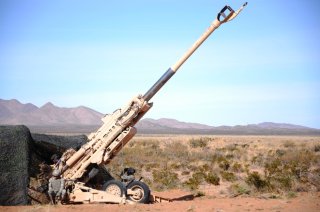The U.S. Army's Excalibur 'Shaped-Trajectory' Rounds Can Kill Anything
While some of Excalibur’s technical specifics are not yet known, the round is engineered with an advanced ability to change course in flight and maneuver to kill an otherwise unreachable target.
Imagine that a mechanized armored unit was approaching uneven terrain and seeking out an enemy that was obscured from view behind a ridge. How should the advancing forces attack? Without a linear approach or line of sight to the target, a heavily armed and armored unit lacks intelligence; it might utilize a drone to observe enemy forces on the other side of a hill. But once the enemy is discovered, advancing forces have few attack options apart from calling for a drone strike or firing a mortar or artillery system with an upward trajectory to descend upon the enemy.
Essentially, a unit’s options in this kind of scenario are limited. For example, just how would an artillery weapon attack an enemy vehicle on the other side of a mountain or beneath a bridge? There are few options without entering a direct line of enemy fire, and even then there may not be an opportunity to pinpoint the obscured target.
These circumstances reveal how today’s ground war commanders continue to be presented with difficult tactical challenges. Further, they reveal why the U.S. Army has partnered with Excalibur-maker Raytheon to engineer the new “shaped trajectory” 155mm precision-guided artillery round. While some of Excalibur’s technical specifics are not yet known, the round is engineered with an advanced ability to change course in flight and maneuver to kill an otherwise unreachable target.
“We want to get to the point where we have target-seeking munitions. Counterintuitively, it lowers the cost per kill as those are expensive munitions. But, when you have the confidence that it's going to seek and destroy the target that you're shooting at, it certainly lowers the number of munitions you have to shoot at it,” Maj. Gen. John Rafferty, director of the Long Range Precision Fires Cross Functional Team at Army Futures Command, told The National Interest in an interview.
The “shaped trajectory” is a revolutionary development, as it enables an unprecedented degree of targeting and attack. Instead of being limited or confined to a standard guided-round trajectory, which descends in a direct and apparent fashing, the “shaped trajectory” round can be pre-programmed to perform a “high-G-U-turn,” altering its course to destroy obscured or hidden targets, developers explain.
“The projectile itself has fins and canards that enable it to steer,” Rafferty said.
Therefore, should a high-altitude drone use high-fidelity cameras to discover a hidden target on the other side of a ridge, a datalink can send the real-time video to maneuverable, ground-based, mechanized command and control units to fire a “shaped trajectory” course-correcting round and destroy the target. This not only greatly shortens the sensor-to-shooter time but also improves survivability by enabling stand-off range precision attacks beyond line of sight.
Kris Osborn is the defense editor for the National Interest. Osborn previously served at the Pentagon as a Highly Qualified Expert with the Office of the Assistant Secretary of the Army—Acquisition, Logistics & Technology. Osborn has also worked as an anchor and on-air military specialist at national TV networks. He has appeared as a guest military expert on Fox News, MSNBC, The Military Channel, and The History Channel. He also has a Master's Degree in Comparative Literature from Columbia University.
Image: Flickr.

